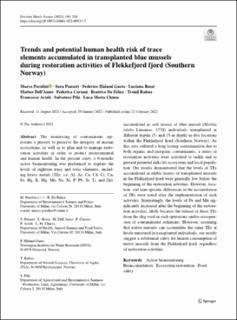Trends and potential human health risk of trace elements accumulated in transplanted blue mussels during restoration activities of Flekkefjord fjord (Southern Norway)
| dc.contributor.author | Parolini, Marco | |
| dc.contributor.author | Panseri, Sara | |
| dc.contributor.author | Gaeta, Federico Håland | |
| dc.contributor.author | Rossi, Luciana | |
| dc.contributor.author | Dell’Anno, Matteo | |
| dc.contributor.author | Ceriani, Federica | |
| dc.contributor.author | De Felice, Beatrice | |
| dc.contributor.author | Rafoss, Trond | |
| dc.contributor.author | Arioli, Francesco | |
| dc.contributor.author | Pilu, Salvatore | |
| dc.contributor.author | Chiesa, Luca Maria | |
| dc.date.accessioned | 2022-07-12T14:48:03Z | |
| dc.date.available | 2022-07-12T14:48:03Z | |
| dc.date.created | 2022-05-23T10:34:45Z | |
| dc.date.issued | 2022 | |
| dc.identifier.citation | Environmental Monitoring & Assessment. 2022, 194, 208. | en_US |
| dc.identifier.issn | 0167-6369 | |
| dc.identifier.uri | https://hdl.handle.net/11250/3004707 | |
| dc.description.abstract | The monitoring of contaminants represents a priority to preserve the integrity of marine ecosystems, as well as to plan and to manage restoration activities in order to protect environmental and human health. In the present study, a 6-months active biomonitoring was performed to explore the levels of eighteen trace and toxic elements, including heavy metals (TEs; i.e. Al, As, Ca, Cd, Cr, Cu, Fe, Hg, K, Mg, Mn, Na, Ni, P, Pb, Sr, Ti, and Zn), accumulated in soft tissues of blue mussel (Mytilus edulis Linnaeus, 1758) individuals transplanted at different depths (5- and 15-m depth) in five locations within the Flekkefjord fjord (Southern Norway). As this area suffered a long-lasting contamination due to both organic and inorganic contaminants, a series of restoration activities were activated to tackle and to prevent potential risks for ecosystem and local population. Our results demonstrated that the levels of TEs accumulated in edible tissues of transplanted mussels in the Flekkefjord fjord were generally low before the beginning of the restoration activities. However, location- and time-specific differences in the accumulation of TEs were noted after the implementation of such activities. Interestingly, the levels of Fe and Mn significantly increased after the beginning of the restoration activities, likely because the release of these TEs from the slag used in such operations and/or resuspension of contaminated sediments. However, assuming that native mussels can accumulate the same TEs at levels measured in transplanted individuals, our results suggest a substantial safety for human consumption of native mussels from the Flekkefjord fjord, regardless of restoration activities. | en_US |
| dc.language.iso | eng | en_US |
| dc.publisher | Springer | en_US |
| dc.rights | Navngivelse 4.0 Internasjonal | * |
| dc.rights.uri | http://creativecommons.org/licenses/by/4.0/deed.no | * |
| dc.title | Trends and potential human health risk of trace elements accumulated in transplanted blue mussels during restoration activities of Flekkefjord fjord (Southern Norway) | en_US |
| dc.type | Peer reviewed | en_US |
| dc.type | Journal article | en_US |
| dc.description.version | publishedVersion | en_US |
| dc.rights.holder | © The Author(s) 2022 | en_US |
| dc.source.pagenumber | 17 | en_US |
| dc.source.volume | 194 | en_US |
| dc.source.journal | Environmental Monitoring & Assessment | en_US |
| dc.identifier.doi | 10.1007/s10661-022-09835-7 | |
| dc.identifier.cristin | 2026416 | |
| dc.source.articlenumber | 208 | en_US |
| cristin.ispublished | true | |
| cristin.fulltext | original | |
| cristin.qualitycode | 1 |
Tilhørende fil(er)
Denne innførselen finnes i følgende samling(er)
-
Publikasjoner fra Cristin - NIVA [2160]
-
Scientific publications [1172]

